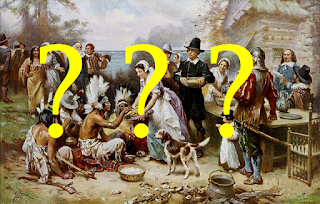
When did the first Thanksgiving Day take
place? Were the Pilgrims who landed at Plymouth
Rock and survived that brutal winter with the help of the local natives the
first to celebrate our nation’s beloved day of gratitude to God in 1621 as we
have been taught?
The answer is ‘nope’.
(Image: The First Thanksgiving by Jean Leon Gerome Ferris, c. 1914)
For a number of several years now there
have been various attempts to correct a popular misconception about American
history on who the originators of the first thanksgiving are. History shows it was not the Pilgrims, but the first intrepid explorers who made it
through a perilous voyage to the New World.
You may have already heard about some of
these ‘First Thanksgiving Contenders’ put forward for consideration by eminent historians:
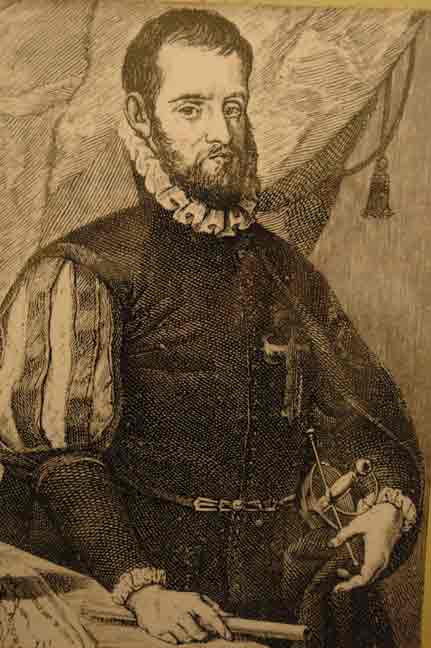 Don
Pedro Menéndez de Avilés: A Spanish explorer who
landed on shore in Florida,
September 8, 1565. He named the new land “St.
Augustine” in honour of St.
Augustine on whose feast day the land was first
sighted, August 28. The native Timucua
tribe welcomed the explorers peacefully.
The day the explorers came ashore, the Spanish thanked God with a Mass
of Thanksgiving, the very first Catholic Mass to be said on what would become North
American land, and afterwards enjoyed a feast with the natives. (For more
information, read Prof. Michael Gannons work, The Cross in the Sand).
Don
Pedro Menéndez de Avilés: A Spanish explorer who
landed on shore in Florida,
September 8, 1565. He named the new land “St.
Augustine” in honour of St.
Augustine on whose feast day the land was first
sighted, August 28. The native Timucua
tribe welcomed the explorers peacefully.
The day the explorers came ashore, the Spanish thanked God with a Mass
of Thanksgiving, the very first Catholic Mass to be said on what would become North
American land, and afterwards enjoyed a feast with the natives. (For more
information, read Prof. Michael Gannons work, The Cross in the Sand).
However,
research shows that wasn’t the first Thanksgiving.
 The French Huguenot (Protestant) explorer René de Goulaine de Laudonnière landed
in Florida a
year before Menendez de Aviles. The
Timucua tribe that would later celebrate with Menendez had welcomed them,
causing René to order a feast of Thanksgiving be celebrated to God on June 30, 1564.
The French Huguenot (Protestant) explorer René de Goulaine de Laudonnière landed
in Florida a
year before Menendez de Aviles. The
Timucua tribe that would later celebrate with Menendez had welcomed them,
causing René to order a feast of Thanksgiving be celebrated to God on June 30, 1564.
Still, that may not be the first
Thanksgiving either!
As the Jacksonville Historical Society Website
points out:
“Can we conclusively determine
that Laudonniere’s 1564 feast is the mother of all American Thanksgivings?
Probably not. It must be noted that many prior European
explorers offered prayers of thanksgiving upon their safe arrivals in Florida,
including Juan Ponce de León in 1513
and 1521, Pánfilo de Narváez in 1528, Hernando
de Soto in 1529, Father Luis Cáncer
de Barbastro in 1549, and Tristán de
Luna in 1559. Also, assuredly, each of these explorers came into contact
with native peoples and, most likely, would have had to rely not only on their
kindness and goodwill, but also their food.” ( Click here to read their article, "America's Real Thanksgiving".)
True, all these explorers are contenders as
having originated the First Thanksgiving, Ponce de Leon’s expedition dated 1513
seems to be the earliest candidate, but
I shall now suggest another nominee that apparently has been completely
overlooked as far as I can tell: I give you.....drum roll please .....
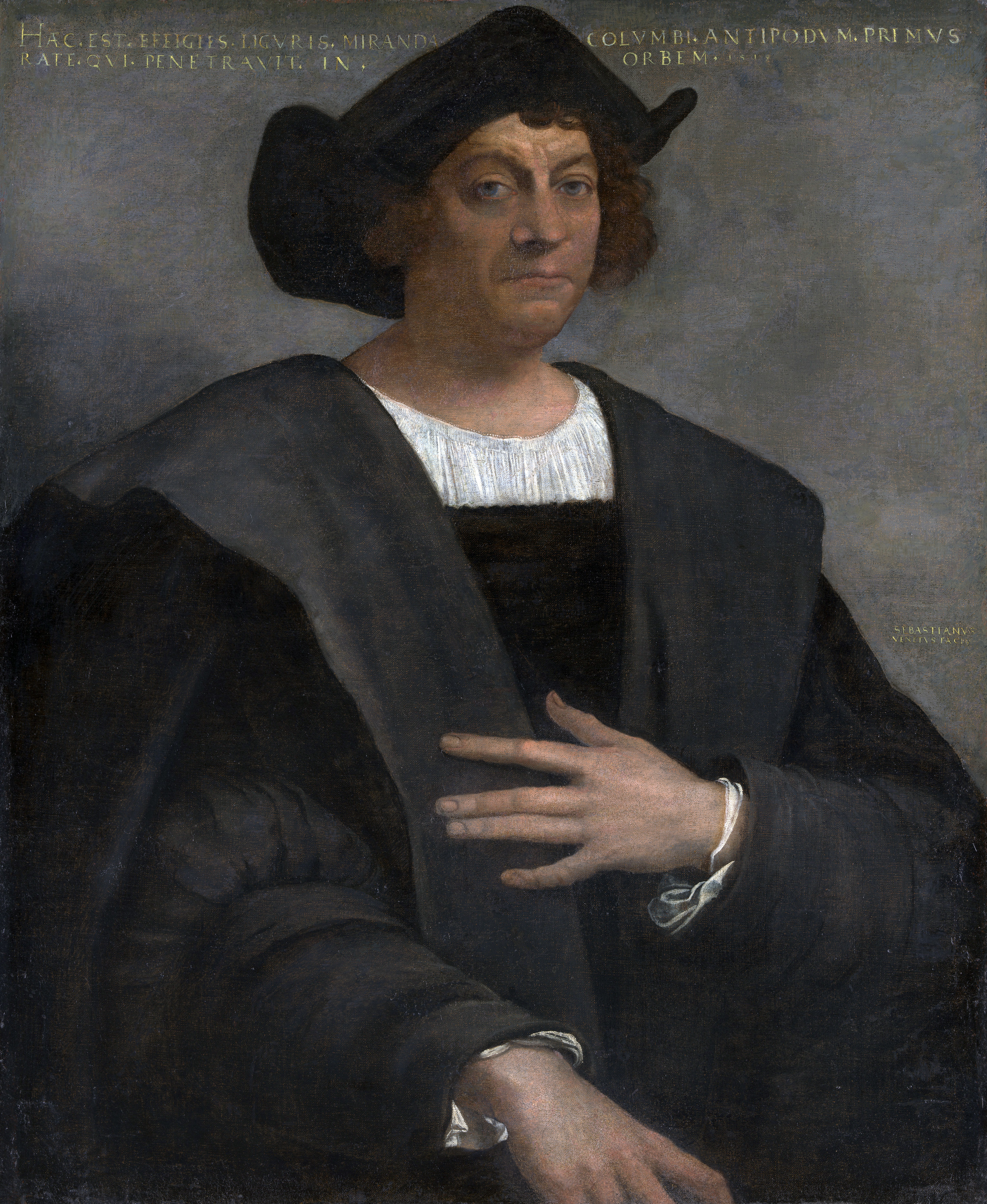
Christopher
Columbus. (Image: posthumous portrait of Columbus by Sebastiano Piombo c. 1520)
What!?
Yes, you read that. Christopher Columbus. During his
second voyage in 1493, he set foot on what would become a United States territory, Puerto Rico, which was
ceded to the US
in 1893 by the Spanish government after the Spanish-America War.
‘But how can he have originated that first
thanksgiving?’ you are probably thinking.
We have no record of a feast day of gratitude celebrated by him on what
is now North American soil. True, but I
pose another question—does the first American
Thanksgiving have to be celebrated directly on American soil to be considered the
first Thanksgiving in the New World?
Since Christopher Columbus is the first of
the European explorers to discover what would one day be called the Americas,
(even though he didn’t know it then), his voyage across the sea was the mother
of all exploratory voyages to the West.
Therefore he is the ‘primordial founding father’ of our American nation
in a manner of speaking. In a that sense he is the ‘first American’ of us all. Of
importance, he gave thanks, and had every reason to.
I won’t go into long details about his early
biography and bore you to death, (you can Google that yourselves!) but I cannot
help but mention his dogged determination in seeking patrons to fund his daring
expedition to achieve what was once thought impossible.
Contrary to popular misconception, the learned
scholars of Columbus’ time had figured out that the world wasn’t flat like
a Spanish tortilla, they understood that technically it was possible to sail to
the rich lands of the Far East by taking a western route, the problem was no
one knew exactly how large the earth was, (or that there were another couple of
hitherto unknown continents in the way! Surprise, surprise!) Could an expedition be stocked well enough
and last the lengthy voyage in that vast territory of hundreds of thousands of leagues
of ocean yet uncharted? In the end the
general consensus was that such a voyage may be possible but unfeasible on a
practical level.

(Image: The Yale world map by "Henricus Martellus Germanus" (Heinrich Hammer), probably from Florence 1490-92. This is a map of the known world before Columbus' historic voyage: Europe and Africa to the left, the Far East on the right. By then, scholars knew the earth was round, but had no idea how large the 'Ocean Sea', our Atlantic ocean was, and if a westward crossing to Asia was possible.)
However, Columbus not only believed it was possible,
but he was fully determined to be prove it could be done. Making extensive studies of historical and
geographic texts, both ancient and modern, he made his own
calculations on how long a journey to China and India might take, and that is
where he encountered many of his difficulties.
His league estimations for such a journey were deemed way too short of
the theoretical mark proposed by the scholars of his time, and therefore no one
wanted to risk their capital funding an already hazardous and uncertain expedition
led by someone who seemed not to have the foggiest notion of what they were planning
to undertake. This may be a crude
comparison, but it is not that different from the latest idea concocted up by idealistic
space exploration enthusiasts ~ vis to
send a handful of determined citizens volunteers selected by an open application process
on a one-way, no-turning-back, lifetime ticket to set up a permanent colony on Mars. In other words, The Mars One Project. True, theoretically it could be done, and if
it could be pulled off, it would be a groundbreaking feat for the annuals of
history and science, but it also appears quite insane where practical purposes
are concerned!

(Image: conceptual art of the Mars-One colony project. Photo credit, Bryan Versteeg.
Well, Columbus
was attempting something along the same lines.
He did not give up on this dream to sail west and spent years attempting to secure a
patron. He first went to King John II of
Portugal in 1485, but was refused not only on account of his miscalculations,
but also because the King’s explorers were busy attempting the Cape of Good
Hope route to Asia around the southern tip of Africa and would not be enticed
by the dubious half-baked promise of a ‘West Passage’.
Our persistent would-be explorer next went
to Spain
where he was fortunate to find influential noble supporters, but his most
important followers would prove to be the Franciscan friars at the monastery La
Rabida near Palos, especially Brother Juan Pérez, former official of Queen
Isabella. Columbus was eventually introduced to the
Spanish court in 1486 and a special commission was set up to investigate his
proposals, however, the commission took much time deliberating and
investigating his calculations. At least
he had the Spanish court interested: for a time they were intrigued with his
idea, and to prevent him from going to another patron, he was awarded a meagre
annual allowance to tide him over. Good
boy, stay put. Here’s some pocket money
for you.
Yet, rather than sit around as the special
committee in Spain dallied, Columbus went to the
Portuguese court again with his daring project in 1488, but was turned down. He didn’t give up and travelled to Venice and Genoa,
but was refused there too and received no encouragement whatsoever. He even sent his brother Bartholomew Columbus
to King Henry VII in England
to see if that monarch might be interested in a Western Route to the Indies,
that too proved a failure.
Columbus again tried the Court of Spain,
and while the committee continued to waste time blowing hot air and weigh in
against his voyage, the crown ordered in 1489 that Columbus be given free food and lodgings in
any city or town under their domain.
Okay, it was another foot in the door, an indication
Spain
was not yet out of the picture, even if he was being treated like a ward of the
state with no proper job to do! In fact,
he wasn’t treated very well, he could barely make ends meet with the allowance
he had been granted, following the Spanish court everywhere as a person with no
fixed abode, accepting the order of free lodgings granted by the charity of the
court. No doubt he took this shabby
treatment all in the spirit of a good son of St. Francis of Assisi ~ he was a member of the Third Order
after all. In fact, Columbus often appeared before the court dressed
in his humble brown robe of the Franciscan order to the point he was mocked for
his ragged appearance, and indeed, his sanity was further questioned on account
of it!
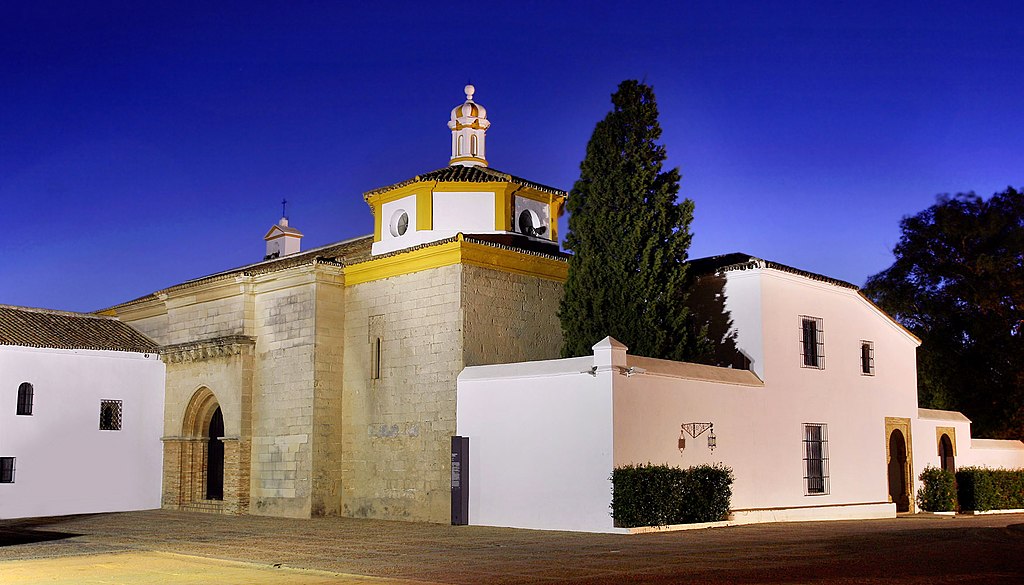
(Image: The Franciscan Monastery of Rabida. Photo by Miguel Ángel 2007.)
However, he didn’t give up and entered several
more years of lobbying and negotiations with the Spanish court despite the
negative outlook. When he still wasn’t
getting anywhere, he decided to try the French court and set out on foot for France in 1491, stopping by the Franciscan La
Rabida monastery where he once again shared his plans with Brother Juan Pérez,
before continuing to France. France too turned down his
proposals, and we can only imagine the frustration he was feeling by then!
In 1492, Columbus
appealed to the Spanish court while it was residing in Cordoba and was rejected—again. If we were with him, by now after all these
years we might just advise the poor blighter to give up, he did his best,
right? We might tell him to have a nice pity-party
for himself, then get on with his life!
In fact, he was at the breaking point.
Leaving the city on a mule, he was on the brink of despair when lo and
behold, he was immediately sent for: the queen had miraculously changed her
mind! Some accounts say King Ferdinand
had intervened in Queen Isabella’s decision to reject Columbus’ proposal and she agreed to fund the
expedition, (the king took credit for the idea, naturally), while in other
records the credit of changing the Queen’s decision belongs to Brother Juan
Pérez of the Franciscan La Rabida monastery, her former adviser. Apparently, after listening to Columbus’ plans before his journey to France, the good brother decided to make a
special appeal to the royal court on Columbus
behalf, and was heard.
At last!
Success! Gracias a Dios! Thanks be to God!
The dream of finding a direct westward
route to the Indies was now within his grasp! When the expedition was finally ready to set
sail, Columbus
chose a very specific date to depart, August 3rd. Why? Because before he set sail he wanted he and
his men to celebrate on August 2nd and give thanks for this great event with those
who never gave up on him despite all the obstacles, the Friars and people of
Palos. (Info: Juan Manzano y Manzan, Cristóbal Colón).
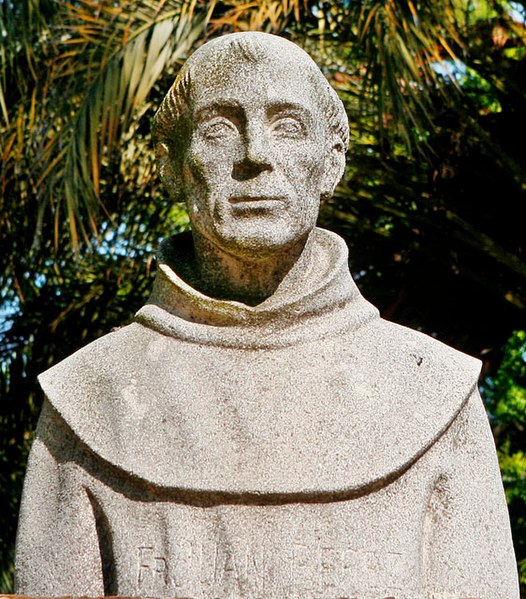
(Image: bust of Brother Juan Pérez, photo by Miguel Ángel, 2007)
First of all, August the 2nd was
and continues to be a very important feast day for the Franciscans, the feast
of Our Lady of the Angels, and Columbus was a Third Order Franciscan. It is the anniversary of the dedication of the
birthplace of the Franciscan Order and the day of a special Indulgence, the
Portiuncula Indulgence. (Click here to read more.) That day in 1492 was certainly an
important day of feasting to the brothers and local residents of Palos,
especially as Our Lady of the Angels was declared their special Patroness
against the perils of the sea fifty years earlier by Pope Eugenius IV. We can only imagine the thanksgiving
jubilation on the day before Columbus
departed after all the tribulations he went through, and that he wished to celebrate
with them. Anyone familiar with Spain could
easily guess there would have been a Mass, and a procession with the famous Marian statue of the monastery, the "Virgen de los Milagros" the Virgin of Miracles. There would of course have been feasting. There’s nothing like a fiesta! Columbus
then withdrew and spent the entire night in prayer, apparently before the statue of Our Lady of Miracles, preparing for his momentous
journey across an ocean never before charted.
(Left: The Portiuncula, Italy. Chapel dedicated to Our Lady of the Angels rebuilt by St. Francis, the birthplace of the Franciscan Order. Right: The statue of Our Lady of Miracles at the Rabida Monastery in Spain. Below: Chapel of La Rabida Monastery, Photo by Marc Ryckaert, 2007)

So,
that celebratory day held on August 2, 1492 in Rabida / Palos, the Feast of Our Lady of
the Angels, may have been the Mother of All Thanksgivings. It may not have been
held on American land, but is nonetheless our first American Thanksgiving ~ if
it were not for Columbus’ determination, his venture may never have taken
place, and someone else may have been granted the honour of becoming the first
'founding father' of modern America.
Of course, for those who insist that for
the ‘First Thanksgiving’ to be recognised as such it should at least have taken
place somewhere in the New World, we would have to turn our attention to the day
Columbus first set foot on San Salvador in 1492. After weeks of sailing with no sight of land,
the men were getting afraid to the point our explorer was facing the prospects
of a brutal mutiny. He finally promised
that if they did not sight land by the feast day of Our Lady of Pillar, October
12th, he would turn the ships around, and sure enough, on that very day he
reached dry land. In thanksgiving, he
knelt and said the following prayer:
“O Lord, eternal and omnipotent God, Thou
hast, by Thy holy word, created the heavens, the earth, and the sea; blessed
and glorified be Thy name; praised be Thy majesty, who hast deigned that, by
means of Thy unworthy servant, Thy sacred name should be acknowledged and made
known in this new quarter of the world.”
(Info: Irving, Washington. A history of the life and
voyages of Christopher Columbus. Paris:
A. and W. Galignani, 1828. p. 237.)

(Image: Columbus, kneeling, claims the island of San Salvador for Spain.)
The Credo,
and the Te Deum praising and thanking
God were also said in addition to other multiple prayers of thanksgiving. That counts as a thanksgiving celebration,
doesn’t it? Of interest, the first
sighting of he New World on the feast of Our Lady of Pillar is also apropos in
conjunction with Columbus’ dream and his unrelenting perseverance to achieve it
despite all the obstacles.
Circa 40 AD, the Apostle St. James the
Greater had embarked on a mission to spread the Gospel to the pagans in what is
now recognised as Spain, however, despite all his efforts, he had
barely made a few converts and was disheartened by the meagre results. In what is now Zaragoza,
Our Lady appeared to him on top of pillar surrounded by Angels with the baby
Jesus in Her arms. She encouraged James,
telling him that the people of Spain
would convert and that their faith would be as strong as the pillar on which
she was standing. She gave him the
pillar in addition to a wooden statue of her image and requested that a chapel be built on the spot. Of interest, theologians note that judging from biblical texts and holy Tradition handed down, the Mother of God was still alive on earth when this visitaion took place, so, it was not an apparition, but a miraculous bi-location event.
(Image: Our Lady of the Pillar, Zaragoza, Spain. The wooden statue sits on the famous jasper pillar draped in a special mantel donated by devotees. The pillar is further covered by a bronze case, also covered by a silver case, seen below the mantel. Our Lady of Pillar has been designated the Patroness of the Hispanic World as her feast day coincides with the discovery of the New World. Photo by Archivaldo, 2007)
Like St. James whose missionary efforts met
with disheartening results in the beginning, Columbus faced similar trials. In addition to his dream of discovering a new
western passage, records also indicate he was inflamed with missionary zeal and
the desire to spread the Gospel to the pagan lands of the Far
East. How fitting
considering his first name ‘Christopher’ means ‘Christ-Bearer’! Of course, we cannot help but notice a
connection between the first thanksgiving feast day of Our Lady of the Angels
in Palos and that of Our Lady of Pilar surrounded by Angels. Just after Columbus had been granted funding for his
expedition after years of rejections and ridicule, picture him coming to the
brink of the ultimate failure in the venture as his men grew afraid and
threatened to mutiny, then, to find victory was again right before him on the
horizon at the last minute! Prayer and
perseverance wins all. We can imagine how
heartfelt his Thanksgiving was that day of Our Lady of Pilar when San Salvador was sighted.
In all, if we consider Columbus as having celebrated the two Mother
of All Thanksgivings, the Mother of all Mothers was at the heart of them both!
Of course, a time-honoured tradition of
looking back on the Pilgrims of future New England as having been the
originators of the holiday will not be effaced so easily, especially as it
might chagrin a number of people to think that the early thanksgivings of America were
predominately Catholic! However, as long as we remember what the
holiday is all about, thanking God for the blessings He sends and the graces He
has given to help us weather our storms in life, whatever they may be, then we
have the right spirit of the holiday, no matter what event we believe is the
first of them. We all receive many
graces amongst the tribulations of this world, and God expects us to come
and thank Him. Remember the Gospel of the ten lepers, when
only one returned to thank Him for His mercy.
Our Lord said: “Were not ten made clean? And where
are the nine? There is no one found to return and give glory to God, but
this stranger.” (Luke 17: 17-18)
Thank the Lord for everything, for without
Him we have nothing.



Yikes. You've been busy. Nice read. Technically the first official thanksgiving was established by Abraham Lincoln I think. Then FDR moved it around for Christmas shopping I think. I would look it up but I'm soooo lazy. But now they tell me Columbus wasn't even Italian so what do I know?
ReplyDeleteHappy Thanksgiving though. We took dad out in VC. He had prime rib
So much for tradition. Now I'm broke and tired. Time for bed. Haha.